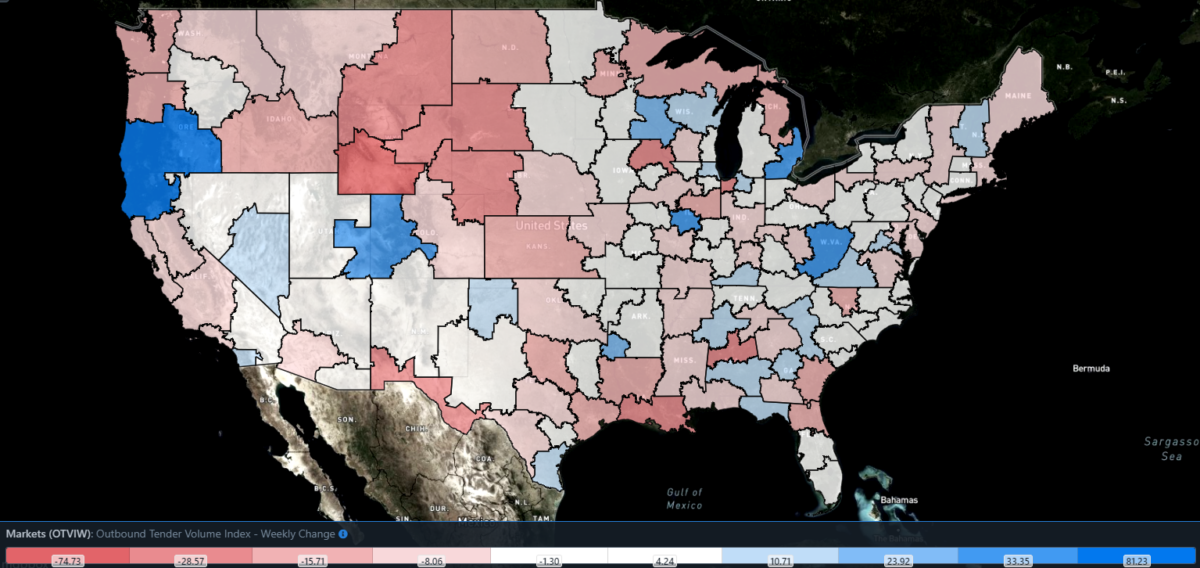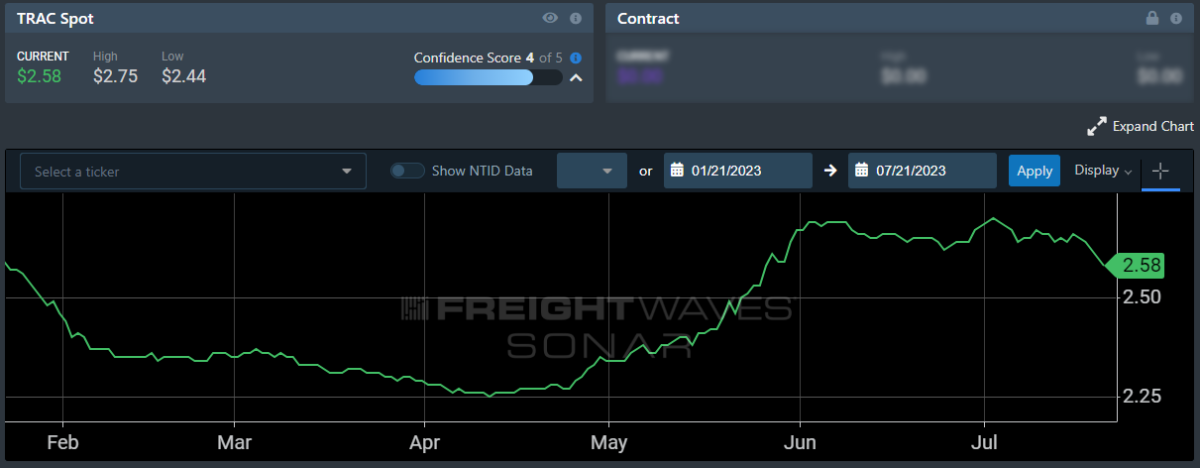This week’s FreightWaves Supply Chain Pricing Power Index: 30 (Shippers)
Last week’s FreightWaves Supply Chain Pricing Power Index: 30 (Shippers)
Three-month FreightWaves Supply Chain Pricing Power Index Outlook: 30 (Shippers)
The FreightWaves Supply Chain Pricing Power Index uses the analytics and data in FreightWaves SONAR to analyze the market and estimate the negotiating power for rates between shippers and carriers.
This week’s Pricing Power Index is based on the following indicators:
Stable is boring, but stable isn’t a bad thing
Freight volumes continue to trend sideways, which is a positive sign overall as the 15th of July traditionally marks a time for slowing demand in the freight market. The question still remains: What do the next two months have in store ahead of the resumption of student loan payments in October? Couple that with the enhanced risk of a Yellow bankruptcy and it’s possible that freight demand holds up better in the coming weeks than originally anticipated.

SONAR: OTVI.USA: 2023 (white), 2022 (orange) and 2021 (green)
To learn more about FreightWaves SONAR, click here.
This week, the Outbound Tender Volume Index (OTVI), which measures national freight demand by shippers’ requests for capacity, fell 0.16% on a week-over-week (w/w) basis. On a year-over-year (y/y) basis, OTVI is down 13.17%, though such y/y comparisons can be colored by significant shifts in tender rejections. OTVI, which includes both accepted and rejected tenders, can be inflated by an uptick in the Outbound Tender Reject Index (OTRI).

SONAR: CLAV.USA: 2023 (white), 2022 (green) and 2021 (blue)
To learn more about FreightWaves SONAR, click here.
Contract Load Accepted Volume (CLAV) is an index that measures accepted load volumes moving under contracted agreements. In short, it is similar to OTVI but without the rejected tenders. Looking at accepted tender volumes, we see a gain of 0.58% w/w as well as a fall of 8.95% y/y. This y/y difference confirms that actual cracks in freight demand — and not merely OTRI’s y/y decline — are driving OTVI lower.
In the most recent Bank of America card spending report, spending continues to track above 2022 levels overall but is being led higher by services spending. Overall card spending through the week ending July 15 was 0.8% higher y/y, but it was airline spending, up 3.4%, entertainment spending, up 4.9%, and restaurant spending, up 4.7%, leading the way. Home improvement and furniture spending continue to drag on overall spending.
The effects of Amazon’s Prime Day (July 11-12) largely had similar impacts to spending as the previous year. So while the event does incentivize spending during a period when spending traditionally slows, it doesn’t necessarily provide a boost that will drive spending to continue throughout the rest of the month.

SONAR: Outbound Tender Volume Index – Weekly Change (OTVIW)
To learn more about FreightWaves SONAR, click here.
Of the 135 total markets, 65 reported weekly increases in tender volumes, but like the vast majority of the time, the major increases stem from smaller freight markets that have less demand overall, thus producing larger swings on a weekly basis. In the map above, markets in red are those that suffered w/w declines in tender volumes, while the blue-shaded markets are areas with weekly volume gains.
While many of the small markets have experienced the increases, one of the markets that has grown over the past week in a significant manner is Chicago, one of the largest markets in the country. The Chicago market has experienced tender volume levels grow by over 10% in the past week.
By mode: The dry van market remains stable, like the broader market, but has actually experienced some growth over the past week. The Van Outbound Tender Volume Index (VOTVI) has increased by 1.08% over the past week, which is a welcome sight for carriers. Despite the increase over the past week, dry van volumes are still 12% lower y/y.
The reefer market, on the flip side, continues to show signs of softening. The reefer market traditionally peaks around the Fourth of July and declines in subsequent months ahead of the holiday season. That trend holds true this year as the Reefer Outbound Tender Volume Index (ROTVI) fell by 3.63% over the past week and is 7% lower y/y.
Capacity was quick to return following the holiday
Any momentum carriers sought to gain over the Fourth of July was short-lived as rejection rates quickly fell back to preholiday levels. With the threat just days away of a Teamsters strike at Yellow, a move that would likely put the company under, the larger impacts would be felt the following week if the Teamsters at UPS were to strike.

SONAR: OTRI.USA: 2023 (white), 2022 (blue) and 2021 (green)
To learn more about FreightWaves SONAR, click here.
Over the past week, OTRI, which measures relative capacity in the market, fell to 2.94%, a change of 14 basis points (bps) from the week prior. OTRI is now 411 bps below year-ago levels, with y/y comparisons becoming only more favorable as the year progresses.
The loose freight market is rearing its head in second-quarter earnings as Knight-Swift, the largest truckload carrier in the country experienced significant deterioration in its operating ratio. Additionally, the company stated its utilization in its truckload segment was the lowest it had ever been in a second quarter in the company’s history.

SONAR: WRI (color)
To learn more about FreightWaves SONAR, click here.
The map above shows the Weighted Rejection Index (WRI), the product of the Outbound Tender Reject Index — Weekly Change and Outbound Tender Market Share, as a way to prioritize rejection rate changes. As capacity is generally finding freight this week, there were limited significant changes across the country.
Of the 135 markets, 71 reported higher rejection rates over the past week, though 51 of those saw increases of only 100 or fewer bps.
The only market that saw any significant change over the past week was Jacksonville, Florida, as rejection rates declined by 409 bps over the past week, the second-largest decline of the 135 freight markets.

To learn more about FreightWaves SONAR, click here.
By mode: The dry van market continues to combat too much capacity in the market as the Van Outbound Rejection Index (VOTRI) continues to trend sideways. Over the past week, VOTRI has declined by just 2 bps to 2.85%.
The reefer market is past its peak and it was a disappointing peak overall as capacity didn’t tighten the way needed to firm up rates in a significant manner. After the Reefer Outbound Tender Reject Index (ROTRI) increased to above 5% prior to the Fourth of July, it quickly returned to the depressed levels, falling to 3.38%, an 85 bps decline w/w.
The recent drop in housing starts shouldn’t have been a huge surprise as flatbed activity has really slowed over the past month and a half. The Flatbed Outbound Tender Reject Index (FOTRI) has been cut nearly in half since June 4. FOTRI did increase over the past week, being the only equipment type to increase, rising 34 bps to 8.87%.
Labor strikes could push spot rates back up
Those looking for strength in the spot rates should be keeping a close eye on the Teamsters and UPS negotiations. As FreightWaves founder and CEO Craig Fuller alluded to on Thursday’s State of Freight webinar, rejection rates will rise and shippers will be forced to “pay up.”
The concern is that following the Fourth of July, carriers very quickly lost any positive momentum in spot rates, returning right back to the level they were throughout much of April and June.

SONAR: National Truckload Index, 7-day average (white; right axis) and dry van contract rate (blue; left axis).
To learn more about FreightWaves SONAR, click here.
This week, the National Truckload Index (NTI) — which includes fuel surcharges and other accessorials — fell 5 cents per mile to $2.23. Falling linehaul rates were the sole culprit behind this week’s loss, as the linehaul variant of the NTI (NTIL) — which excludes fuel surcharges and other accessorials — fell by 5 cents per mile w/w to $1.63.
Contract rates have started the third quarter with a whimper, as the softness in the freight market continues to show up. Knight-Swift highlighted that pricing pressure intensified as the soft freight market persists. Contract rates — which exclude fuel surcharges and other accessorials like the NTIL — fell 2 cents per mile w/w to $2.37 per mile.

To learn more about FreightWaves SONAR, click here.
The chart above shows the spread between the NTIL and dry van contract rates, revealing the index has fallen to all-time lows in the data set, which dates to early 2019. Throughout that year, contract rates exceeded spot rates, leading to a record number of bankruptcies in the space. Once COVID-19 spread, spot rates reacted quickly, rising to record highs seemingly weekly, while contract rates slowly crept higher throughout 2021.
Despite this spread narrowing significantly early in the year, tightening by 20 cents per mile in January, it has widened again throughout the year to date. As linehaul spot rates remain 65 cents below contract rates, there is still plenty of room for contract rates to decline — or for spot rates to rise — in the remainder of the year.

To learn more about FreightWaves TRAC, click here.
Carrier momentum along the Los Angeles to Dallas lane is dwindling for a combination of reasons: Carriers are accepting basically everything into Dallas and rejection rates out of Los Angeles have stopped their rise. Over the past week, the FreightWaves TRAC rate from Los Angeles to Dallas fell another 3 cents per mile to $1.99, the lowest level since June 9.

To learn more about FreightWaves TRAC, click here.
A similar phenomenon is happening from Atlanta to Philadelphia. The FreightWaves TRAC rate has accelerated its downward move over the past week, falling by 7 cents per mile to $2.58 per mile. Even with the decline, rates are still elevated compared to where they were from February through May.
For more information on FreightWaves’ research, please contact Michael Rudolph at [email protected] or Tony Mulvey at [email protected].











Jose
I said it once and I will say it again, Disclaimer I don’t work for Yellow, UPS or any major Company, and I am not a teamster or work for any union, I don’t have any benefit or interest in the matter, but I will offer my opinion. This is not a problem and has an easy solution. Unfortunately, the case is that Executives and Officers in any Company are never willing to give up or take a pay cut themselves, whether it is on Salary, benefits, etc. in order for the rest of the Company employees to make a better living themselves or to help the Company survive. The way they see it, is that corporate should never sacrifice and that the rest of the company employees not at Corporate Offices should somehow or can somehow sacrifice themselves. This is the hypocrisy, Corporate Executives and Officers make millions in Wages or Salaries, Compensation, etc., etc. at any major Company like Yellow, or UPS etc. and they cannot or will not sacrifice or give up anything themselves, be in Wages, Salaries, Compensation, Benefits, Commissions, etc., etc. to help the Company they run or work for “Survive”, but they expect that the rest of the Company Employees somehow sacrifice whatever little money they make, or give up their benefits, or compensation to help the company “Survive”. If those employees can barely get by, why should they give up anything else, when they have given their all. At this point they have nothing else to lose. So my message to Yellow and UPS Corporate Executives and Officers is you take a Pay Cut, you Sacrifice and “Now” you give up something back to the Company that you Run, and Work for and Pays you. Go live more modestly and spend less, trust me you are not going to die you will survive, we all do.